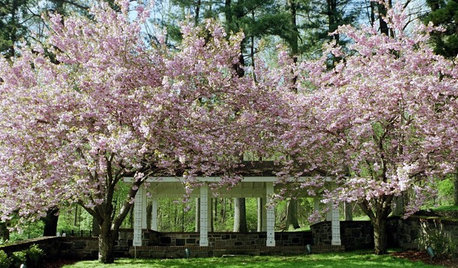Cherry tree pruning
tmc2009
13 years ago
Related Stories

GARDENING GUIDESPlant Black Cherry Trees for the Birds and Bees
Plant Prunus serotina in the Central and Eastern U.S. for spring flowers, interesting bark and beautiful fall color
Full Story
EDIBLE GARDENSHow to Grow Your Own Luscious Cherries
Nope, they’re not the easiest fruit to grow. But with spectacular blossoms and pies as possibilities, cherries are sure worth a try
Full Story
WINTER GARDENINGPruning Secrets for Exquisite Roses
Encourage gorgeous blooms year after year with this time-tested advice on how to prune your rosebush in winter for health and shape
Full Story
GARDENING GUIDESHow to Prune Your Flowering Shrubs for the Best Blooms
Less is often more when it comes to properly pruning flowering shrubs. Here’s what to do and why
Full Story
GARDENING GUIDESGot Frost-Damaged Plants? How It Happens, and When and How to Prune
Crispy brown leaves are a sure sign that Jack Frost has been to your neighborhood
Full Story
EDIBLE GARDENSGrow Plum Hybrids for Your Favorite Fruit Flavors
Plums are cozying up with apricots, peaches and even cherries — here’s how to grow these hybrids for the best aspects of each
Full Story
MORE ROOMSCherry Blossoms Spring to 100
This years marks the centennial of the beautiful trees' arrival on our shores. Below, a few ways to celebrate with your landscape and décor
Full Story
EDIBLE GARDENSHow to Grow 10 Favorite Fruit Trees at Home
Plant a mini orchard in fall, winter or early spring to enjoy fresh-off-the-tree fruit the following year
Full Story
GARDENING GUIDES5 Best-Behaved Trees to Grace a Patio
Big enough for shade but small enough for easy care, these amiable trees mind their manners in a modest outdoor space
Full Story
GARDENING AND LANDSCAPINGCrazy for Fruit Trees
Whether a single citrus or a mini apple orchard, even the smallest landscape space can bear deliriously delicious fruit
Full StoryMore Discussions








alan haigh
tcstoehr
Related Professionals
Reading Landscape Architects & Landscape Designers · Ashburn Landscape Architects & Landscape Designers · Redondo Beach Landscape Architects & Landscape Designers · Roosevelt Landscape Architects & Landscape Designers · West Chester Landscape Architects & Landscape Designers · Maple Heights Landscape Architects & Landscape Designers · Lakeland Landscape Contractors · Andover Landscape Contractors · Deerfield Landscape Contractors · Glendale Heights Landscape Contractors · Mason Landscape Contractors · Monterey Landscape Contractors · North Plainfield Landscape Contractors · Oak Forest Landscape Contractors · Quincy Landscape Contractorsalan haigh
Scott F Smith
alan haigh
franktank232
alan haigh
Scott F Smith
Scott F Smith
alan haigh
Scott F Smith
alan haigh
hoosierquilt USDA 10A Sunset 23 Vista CA
nadine_fahrlander_gmail_com